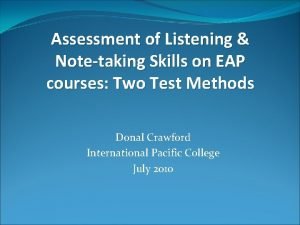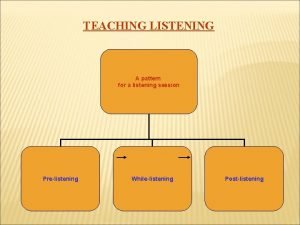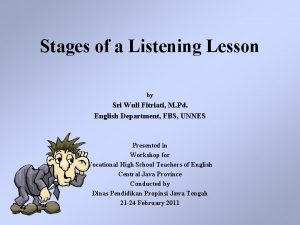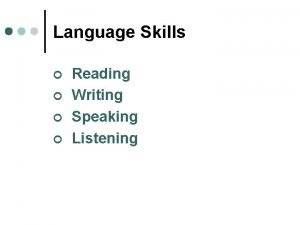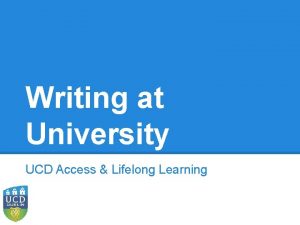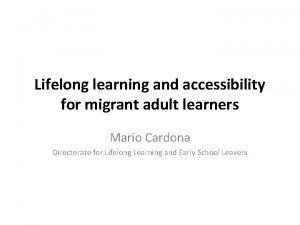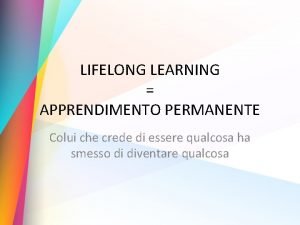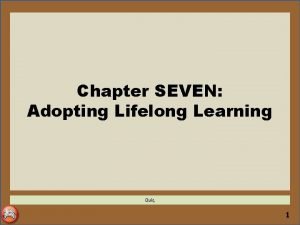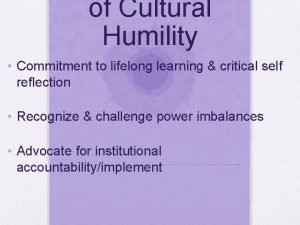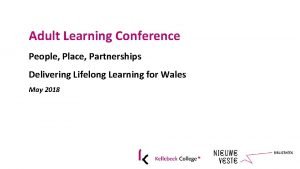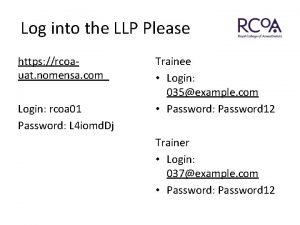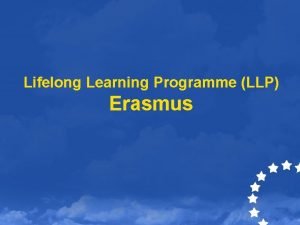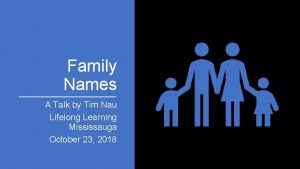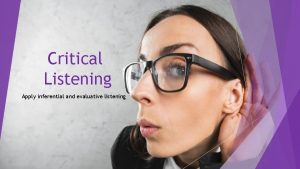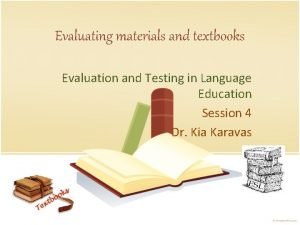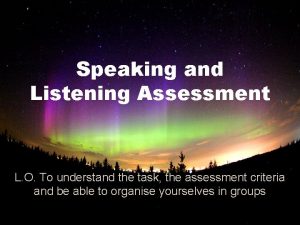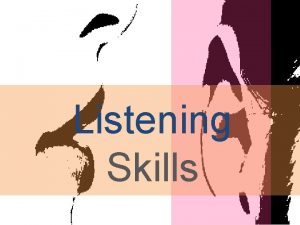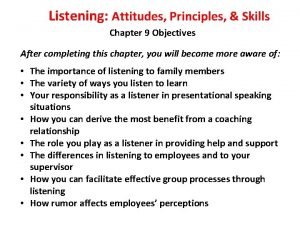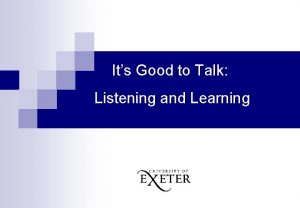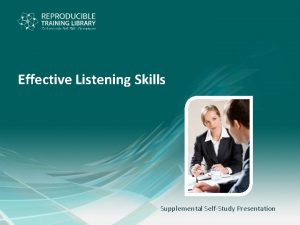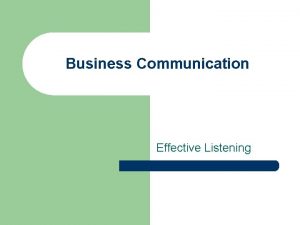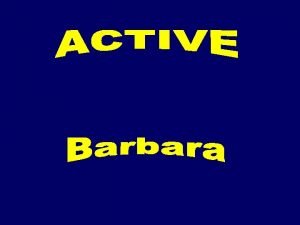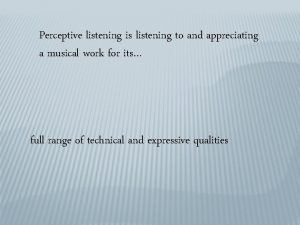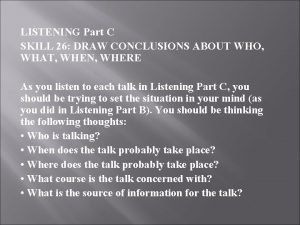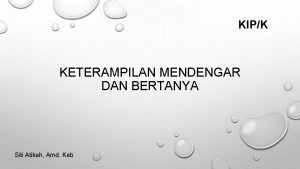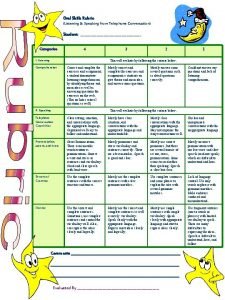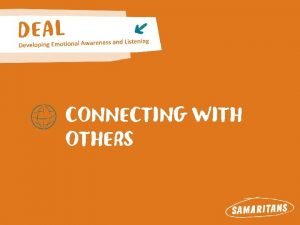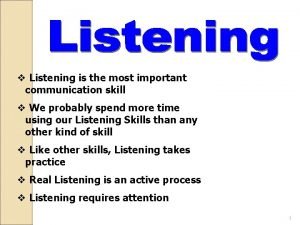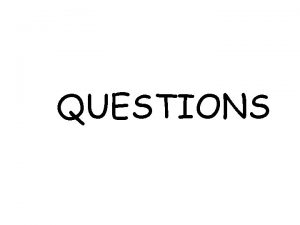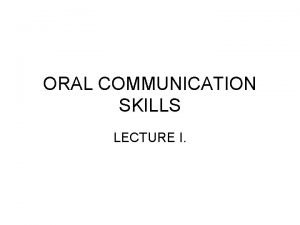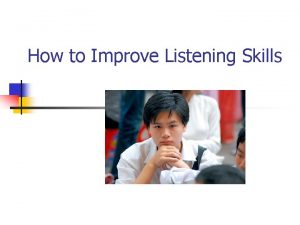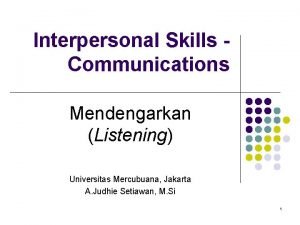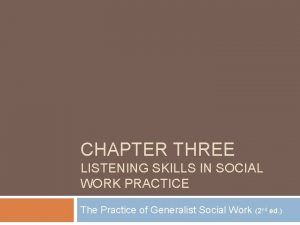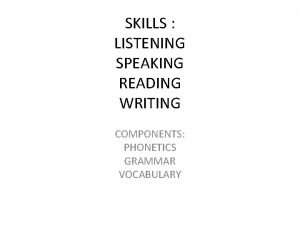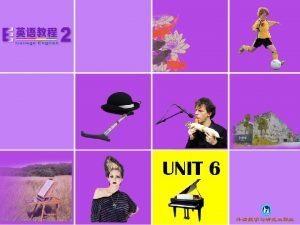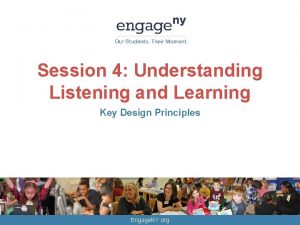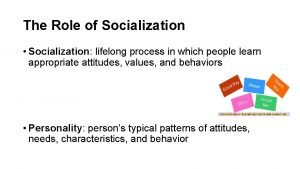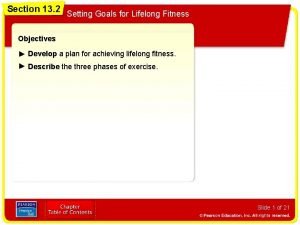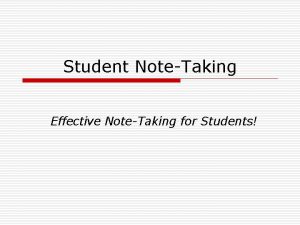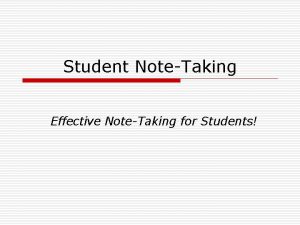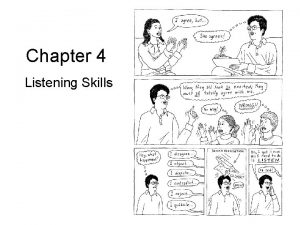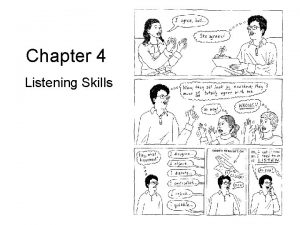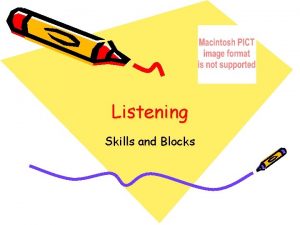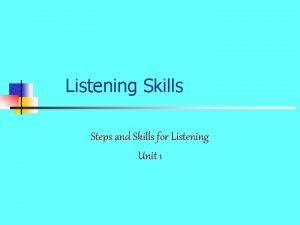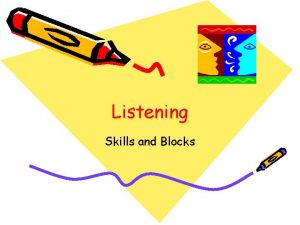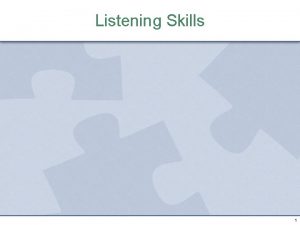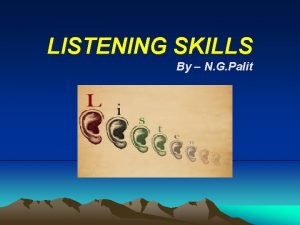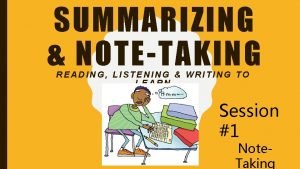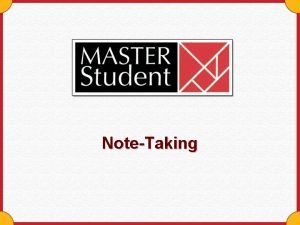Lifelong Learning Skills Reading Evaluating Listening Memorizing Notetaking





























































- Slides: 61

Lifelong Learning Skills Reading, Evaluating, Listening, Memorizing, Notetaking, Summarizing

The Cornell Method of Notetaking



Five Steps of the Cornell Method Record – write down appropriate notes as you listen or read 2. Reduce – soon after listening, clarify notes and summarize 1. main ideas at the bottom and key words in the left column. 3. Recite – go over the notes by testing yourself and reciting 4. Reflect – think about how this new information relates to 5. Review- read over and study the notes again to reinforce important points out loud using the cues from the left column what you already know & believe from life experience and prior learning your memory at key points in time. Walter Pauk, How to Study in College, 9 th edition (Boston: Houghton Mifflin, 2007).


Good source for Cornell notetaking method and other study skills Walter Pauk, How to Study in College, 9 th edition (Boston: Houghton Mifflin, 2007). (If you purchase, get a used 8 th or 7 th edition- much cheaper ).

Lifelong Learning Skills: Advanced Reading

Lifelong reading • Carl Sandburg- “All my life I have been trying to learn to read, to see, and hear, and to write. ” • Goethe, the great German author, wrote: “The dear good people don’t know how long it takes to learn to read. I’ve been at it eighty years, and can’t say yet that I’ve reached the goal. ”

Equivalent of a college eduction if fully used and applied to the Great Books

The Four Levels of Reading 1. 2. 3. 4. Elementary Reading Inspectional Reading Analytical Reading Syntopical Reading

1. Elementary Reading • Achieving basic or initial literacy • Learning to recognize individual words • Understanding what a sentence says

2. Inspectional Reading • Read the Introductory matter – Title page – Preface – Foreward – Introduction • Read Table of Contents • Survey the Index • Read the Publisher’s blurb • Read Summary Statements in pivotal chapters • Dip in here & there, reading 2 -3 pages

Notetaking During Inspectional Reading – Structural Notetaking • What kind of book is it ? – Fiction / Non-fiction

Structural Notetaking, contd. • What is it about as a whole? • What is the structural order of the book? • Is the book relevant or worthwhile for a more complete reading?

3. Analytical Reading • Thorough and complete reading using organized questions • Chewing, swallowing, and digesting a book – Deep reading • Understanding a book’s purpose, structure & problems; interpreting the author’s terms, propositions, & arguments; and critiquing and evaluating the book fairly.

4. Syntopical Reading Using some of the steps in the other types of reading, compare two or more books on the same subject – analyze the common issues, questions, and discussions You could call this horizontal reading in contrast to vertical deep reading of a single book

Lifelong Learning Skills: Evaluating Sources Preliminary Evaluations n Inspectional Reading Evaluation n Author Evaluation n Publisher Evaluation

Author Evaluation n n Determine the authors’ credentials Note if the authors teach at a seminary or Christian college – If they teach at an evangelical school, they will have signed a doctrinal statement This gives an idea of their beliefs. _ Sometimes, but not always, the authors’ educational training may suggest their beliefs. However, beliefs change and may not correspond with a school’s views. - Try to determine the author’s view of the Bible


Publisher evaluation n Preliminary evaluation of a book – one can sometimes get clues to the likely perspective of a book by knowing about the publisher



The Five Ways we Learn 1. 2. 3. 4. 5. L…Listen E…Experiment A…Act R…Read and Reflect N…Note (to observe carefully) (Ultimately we learn and know through God’s revelation in Scripture & nature, and with the mental and sensing abilities he has given us. )

1. LISTEN n Education is the ability to listen to almost anything without losing your temper or your selfconfidence. -Robert Frost n He listens well who takes notes. – Dante Alighieri

Listening principles and hints n Prepare yourself spiritually to listen n Minimize physical distractions n Use an active mind to interact mentally

2. Experiment Test and try out a hypothesis in controlled and systematic study n Use the Scientific Method n – – – 1. Define the problem or question 2. Make initial observations, and study 3. Form a hypothesis with predictions of results 4. Do a controlled experiment or study to test the hypothesis 5. Analyze & interpret the results, form an explanation/conclusion

3. Act – learn by doing n What are some examples of learning by doing ? (in general & in the church)

3. Act – learn by doing Apprentices learn by doing, with a mentor guiding n Act on your environment, interact, do something and observe what happens. n Practice, Practice and get coaching & feedback n

Learn by Doing : Experiential Learning n Plan the learning experience by setting objectives, using observation checklists, etc. n Use a logbook for recording observations n Use structured discussions, debriefings, diaries, peer feedback for reflection n Use case studies, role playing, etc. as substitute experiences n See Graham Gibbs, “Learning by Doing” http: //ww 2. glos. ac. uk/gdn/gibbs

4. Read and Reflect n n Do inspectional reading Read analytically Do Syntopical reading Reflect on your reading

5. Note – Observe Carefully n “Note” means “to observe carefully; notice; perceive. ” (American Heritage Dictionary)

Principles of Memorizing 1. Seeing 2. Hearing and Speaking 3. Writing 4. Reviewing 5. Associating



Regular Review of Notes can counteract memory drop-off Review times can decrease over time


Memory by association

Taking Notes Even squirrels take notes if given the tools.

Kinds of Notes from Written Sources I. Notes Using Quotation II. Notes in Shortened Form III. Notes of Your Own Thoughts (in response to reading)

Kinds of Notes I. Notes Using Quotation A. Direct Quotation- words are copied exactly *use sparingly when the author says it strikingly *do not use lengthy quotes *do not use strings of quotes *always indicate quotes in your notes & paper B. Direct Quotation with minor changes C. Quotation of a Quote D. Quotation from a Footnote

Direct quotation with minor changes • Use ellipsis (…) to indicate omissions (but don’t make any omissions that change meaning) • Use brackets to indicate [ words added ] • Change of capitalization, punctuation or verb tense allowed to match context

Kinds of Notes II. Notes in Shortened Form A. Precis- information written in your own words, maintaining the essential tone & meaning of the original B. Paraphrase – a rewording of the original in the same order and with the details of the original- simplifies or clarifies, but may be as long as the original C. Summary –a condensation of the key ideas in a passage, leaving out details, illustrations or examples. Concise presentation of the essentials in your own words. D. Outline notes – notes of main ideas indicating the structure of the passage in outline form

Kinds of Notes III. Notes of your own thoughts (in response to reading) A. Critical comment notes B. Insight notes from reading

Sample text “Our task is to find out what the commandments for this ancient covenant tell us about the will of God today. If God gave us new commandments in each new situation, speaking directly to each of us, we would not have to consult the ancient words. As it is, we read his commandments as they were spoken to other people – people with customs and a language strange to ours, people who never wondered whether it is right or wrong before God to remove an irreversibly brain-damaged person from a respirator. So the question of this book will be: can the ancient commandments tell us, in our time and our place, what God expects us to do? ” ______________________ Lewis B. Smedes, Mere Morality: What God Expects from Ordinary People ( Grand Rapids, Mich. : William B. Eerdmans Publishing, 1983), 5.

What type of note is this? • “Our task… [ is to discover if ] the ancient commandments tell us, in our time and our place, what God expects us to do. ” • Direct quotation with changes.

What type of note is this? • Our job is to determine what God says through his commands to us. Since we don’t receive direct guidance for each new experience, we still need to look to the Bible, in spite of the fact that it was written to a people with a very different culture. We face new ethical dilemmas today, and therefore, we need to explore how the Scriptures from biblical times can guide us in the here and now. • Paraphrase

What type of note is this? • Smede says that we must do is to discover what the 10 commandments tell us about God’s will. God has spoken to us, his people, via the language and customs and culture of a people foreign to us, people who have never had to face the ethical questions facing us today in our society. His book explores whether God’s commandments tell us what to do. • PRECIS

What type of note is this? • Smede implies that if God addressed each of us separately, there would be no difficulty in interpreting God’s will, since we would not have to wrestle with what the commandments are saying to us. • Summary


Summary and Paraphrase Practice Quote from Richard Peace’s book, Pilgrimage “For me, I suppose, books have been the prime resource I have used throughout my Christian life. I love reading, always have , and so it was natural that I would turn in this direction in my Christian life. Books, however, are not without problems. For one thing, we cannot assume (as some seem to do) that merely by reading something in a book this insight will become a part of our lives. Growth is not that simple. It is true that we read may spark a chain of events that eventually does influence our life-style, but finding the insight in a book is only the first step, not the last. Secondly, not all books are of equal value, nor for that matter, can we trust everything we read in a book. This is obvious when it is said, but in fact many people tend to treat books as if they were almost sacred. Yet a great many books published each year are not worth the paper on which they are printed. Likewise, a lot of things which find their way into print are simply not true. For books to be useful to us, we have to develop a sense of discrimination. We have to learn not to waste our time on certain books, and we have to develop the ability to spot faulty arguments or misleading statements in those that we do choose to read. ”

Tools for Notetaking • Active mind • Recording device • • Pen or pencil Computer Copy machine Audio (cassette or digital) or video recorder (camcorder) • Organizing method • Card coding & numbering • Computer program –word processing, database, note • Storage and Retrieval method • Cards, notebook, paper • Computer • Cassette/cd/dvd

Mechanical aspects of Notetaking • • 1. Use some systematic size or form 2. Write on one side only 3. Before taking notes on a source make a bibliographic card 4. Use an identifying symbol or letter on the bibliographic card • 5. Use one card –one source – one idea • 6. Write the page number of your source & identifying letter • • 7. Determine how you plan to use your note. 8. Use abbreviations that are useful to you. 9. Be mindful of any categories for organizing 10. Get diverse facts and opinions (distinguish facts from opinions)

Bibliographical Cards & Notetaking • Select a book card or periodical card • Enter information about your source • Assign an identifying letter to the source



Writing notes on a notecard, etc. n On the top left indicate the identifying letter of the source and the number of the note from that source. n On the top right indicate the page number in the source where you took the note from. n Be sure to use quotation marks in your note if you quoted from your source.


Notetaking Software: Go. Binder Enables recording, saving, and finding notes; Calendar, goals & contacts


Avoiding Plagiarism n 1. Quoting- “Put in quotations everything that comes directly from the text, especially when taking notes. ” 1 n 2. Paraphrasing – – A. Read over the text – B. Hide or cover the text – C. Write out the material in your own words – D. Look over your paraphrase to see if it is accurate without accidentally using the same phrasing & words 1“Strategies to Avoid Plagiarism, ” Writing Tutorial Services, Indiana Universtiy, 17 Jan. 2003, http: //www. indiana. edu/~wts/plagiarism. html.
 Listening and notetaking skills
Listening and notetaking skills Pre listening while-listening and post listening
Pre listening while-listening and post listening While listening stage
While listening stage Receptive skills listening and reading
Receptive skills listening and reading Listening speaking reading writing skills
Listening speaking reading writing skills While reading activities
While reading activities Lifelong learning essay conclusion
Lifelong learning essay conclusion Is socialization a lifelong process
Is socialization a lifelong process Lifelong learning malta
Lifelong learning malta Adopting lifelong learning
Adopting lifelong learning Cos'è il lifelong learning
Cos'è il lifelong learning Startse university
Startse university Adopting lifelong learning
Adopting lifelong learning Lifelong learning assessment
Lifelong learning assessment Lifelong learning and critical self-reflection
Lifelong learning and critical self-reflection Lifelong learning conference 2018
Lifelong learning conference 2018 Lifelong learning cartoon
Lifelong learning cartoon Llp rcoa login
Llp rcoa login Llp erasmus
Llp erasmus Lifelong learning mississauga
Lifelong learning mississauga Active listening involves
Active listening involves Evaluative listening examples
Evaluative listening examples Checklist for evaluating learning materials
Checklist for evaluating learning materials Cuadro comparativo de e-learning b-learning y m-learning
Cuadro comparativo de e-learning b-learning y m-learning Testing listening comprehension
Testing listening comprehension Speaking and listening assessment
Speaking and listening assessment Listening skills objectives
Listening skills objectives Objectives of listening
Objectives of listening Listening aims
Listening aims Presentation on listening skills
Presentation on listening skills Types of listening
Types of listening Active listening examples
Active listening examples Success criteria for listening skills
Success criteria for listening skills The way sounds are woven together
The way sounds are woven together Nature of listening
Nature of listening Listening skills in social work
Listening skills in social work When you engage in unprocessed note taking, you
When you engage in unprocessed note taking, you Listening skills conclusion
Listening skills conclusion Listening skills objectives
Listening skills objectives Listening and questioning skills
Listening and questioning skills Action plan to improve listening skills
Action plan to improve listening skills Listening skills rubric
Listening skills rubric Bottom up approach in listening
Bottom up approach in listening Active listening wheel
Active listening wheel Mindful listening key skills
Mindful listening key skills Insensitive listening
Insensitive listening Test your listening skills
Test your listening skills Conclusion of communication process
Conclusion of communication process Listening skills
Listening skills Importance of listening
Importance of listening Interpersonal listening
Interpersonal listening Social work listening skills
Social work listening skills Listening speaking reading writing are the components in
Listening speaking reading writing are the components in Grammar listening speaking reading writing
Grammar listening speaking reading writing Grammar listening speaking reading writing
Grammar listening speaking reading writing Ckla listening and learning
Ckla listening and learning Intra personal skill
Intra personal skill What are the soft skills
What are the soft skills Ontario skills passport
Ontario skills passport Process of socialization
Process of socialization Chapter 13 exercise and lifelong fitness
Chapter 13 exercise and lifelong fitness Teratogens examples
Teratogens examples
